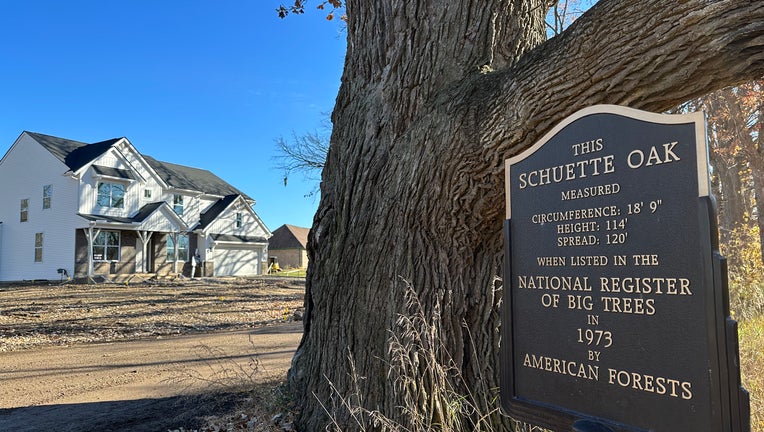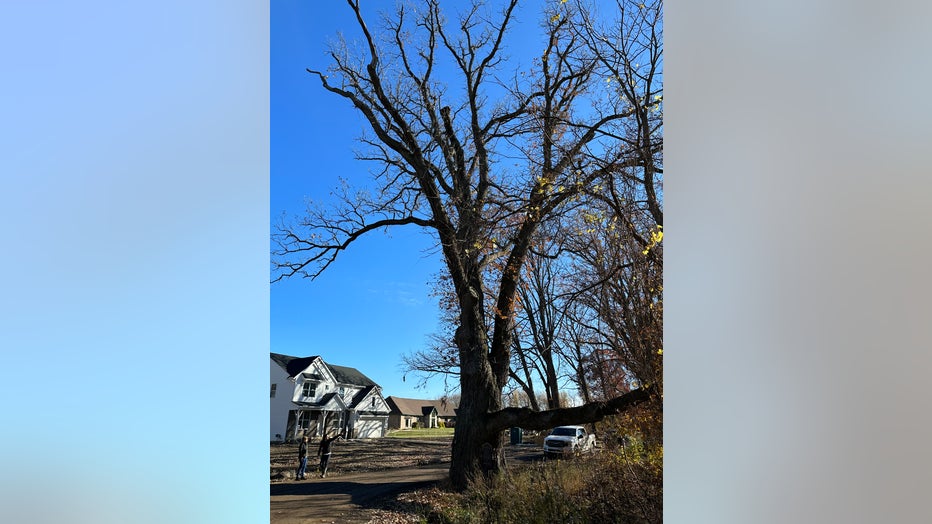Oakland Township residents fear newly-built house threatens 500-year-old grand champion tree

The Schuette Oak, a tree estimated to be 500 years old received historic designation in 1979. A home built across the street threatens its livelihood, residents say.
OAKLAND TOWNSHIP, Mich. (FOX 2) - Could a new housing development in Oakland Township kill a 500-year-old tree?
Fans of the Historic Grand Champion Schuette Oak grew worried after a home that was built across the street from the tree got too close for comfort. Members of the township's Historic District Commission questioned whether the tree was permanently damaged when its roots were cut to make room for a gas line to the new home.
"When we saw them rip up the roots, people literally called 911," said Maureen Moons, a longtime resident of the community. "This was the root system for this tree - this was all roots."
Moons was gesturing to the opposite side of Rush Road, toward the ditch that runs in front of a newly built home. On the other side, where the street meets with Letts Road, is the massive tree. It's more than 21 feet around and is 120 feet high.
It's believed to be older than any home in Michigan and was a popular place to find arrow heads made by indigenous people. Tree experts say it's a miracle the oak is still standing after all the development in Metro Detroit.
It was spared long enough it eventually received a special historical designation. A sign in front of the tree says it was listed in the National Register of Big Trees in 1973. At that time, it was two feet smaller in circumference and six feet shorter.
Over time, the township has designated special protections for the tree. Letts Road, which runs next to the tree actually bends around the trunk. While a headache for the road commission and even the site of vehicle crashes, the tree holds a special place for many of Oakland Township's residents.
"If a car hits it, we're over there immediately to repair it since we don't want bugs to get in," said Barbara Barber, the preservation planner of the historical society. "We're strange in Oakland Township. We're land lovers and tree lovers and we love our environment."
RELATED: Invasive worm that causes Beech leaf disease spreading to Oakland and Wayne counties
However, the historic commission's protections for the tree don't include the roots under the ground. For as tall as the tree is, its root system may travel three times as far and the protective easement from the township extends only 15 feet around the tree.

The Schuette Oak is believed to be older than any home in Michigan and was a popular place to find arrow heads made by indigenous people. Tree experts say it's a miracle the oak is still standing after all the development in Metro Detroit.
On Oct. 18 this year, workers with Consumers Energy were spotted digging a ditch, chopping up roots, and installing a gas line hook-up for the new home, prompting concern. Plans for the home's driveway created more panic because the weight of the cement would be a "death knell" for the tree, Moons said.
"To have cement over the roots and create a lack of water, the balance would be disrupted for the tree," she said.
A similar worry spread among members of the Historic District Commission, who met Oct. 19.
"This is a huge problem," said Commissioner Mark Gerhard.
"Isn't there a sign on the tree? And he (the developer) could read. And he's in an historic area, and he didn't pay any attention to it?" said Trustee Rep. Lana Mangiapane. "I think this is a serious thing that's happened."
"There's no doubt it's not serious. It's just flagrant," said Chairperson David Phillips.
"This is serious since they tapped into the gas line - why wouldn't they tap in further south? Why would you do that 20 feet from he trunk and rip up all the root system?" Barber asked at the time.
It's not out of the ordinary for inadvertent development to end in damage to historical trees, Ian Leahy, the vice president of urban forestry at American Forests wrote in an email.
"(A) lack of enforcement of ordinances can lead to compaction under the tree or damage to it," he said. "Obviously, carving names and such is a temptation, but more subtly trees need oxygen within the soil. When it is compressed by foot traffic or vehicles, that oxygen is forced out and respiration is more difficult."
American Forests is the group that designated the Schuette Oak as a champion tree. Records from the institution show the tree's recording in 1972.
Kay Sicheneder, a consulting arborist at Savatree and expert in trees said conflict happens "when trees and people and their activity meet."
"Sometimes, the activity injures the tree and sometimes the tree causes damage to infrastructure or structures. Managing trees in urban areas requires the involvement of educated and experienced arborists," she wrote in an email.
MORE: Algal blooms in Lake Erie and Saginaw Bay cost Michigan $5.9M a year, study finds
Owen Tree Service who contracts with the township gave the tree a deep root fertilization treatment after commissioners grew concerned the tree's canopy wasn't filling out as fully. Tom Morgan, spokesman for the service said it could take a year or two to know what kind of damage the root cutting did to the tree.
He's hopeful the root structure extends enough away from the road it will be okay.
"This tree has obviously been next to that road for so many years, it's obviously compensated by growing roots in other areas," Morgan said. "Primarily in the field to the west and under the road."
Barber said the developer started building after it received a permit from the township. The reason the historic commission was never notified is that the required permit didn't conflict with the tree's protections since it happened on an entirely different parcel of land - even if its roots still extended that far.
The tree "never showed up on the radar" of any township planning or building board since it didn't overlap with the historic commission's jurisdiction. Moons says "the right hand didn't know what the left hand was doing."
With the tree's health in question, money was allocated Owen Tree Service for another deep root fertilization next year. The commission expected longer term solutions would also be necessary. The historic commission is also considering expanding the protective radius around the tree from 15 feet to 60 feet, which would make it show up during any permit request in connected property.
While the home can't be moved, the planned driveway will be. Barber said the developer rerouted it to be more than 100 feet away from the trunk.

